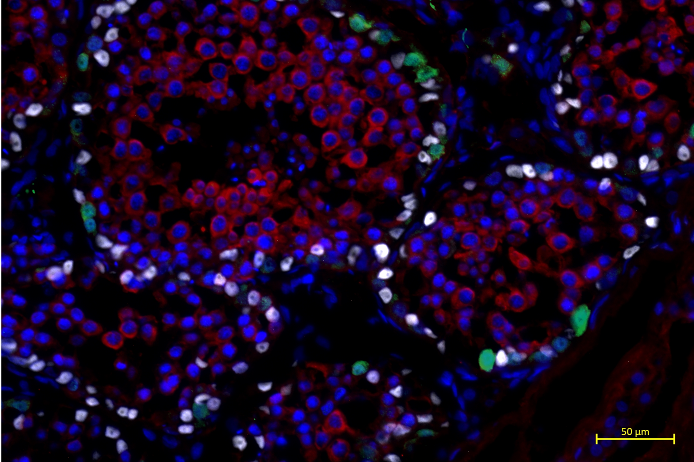Understanding this process is a prerequisite for enabling the formation of male germ cells "in the test tube". This procedure is becoming increasingly important because it can be used to preserve and multiply the genetic potential of valuable individuals from which no vital sperm can be obtained. A science team at the Leibniz Institute for Zoo and Wildlife Research (Leibniz-IZW), Berlin, and at the University of Texas at San Antonio, USA, has now identified molecular markers for the most important cell types in the testes of domestic cats and endangered cat species. This is the prerequisite to generate male germ cells in the test tube. The research project is funded by an Einstein Junior Fellowship at the Humboldt University of Berlin and by the National Institutes of Health, USA. These findings have been published in the scientific journal "Theriogenology Wild".
Of the 39 cat species that exist in the world, 18 are listed on the "Red List" of the International Union for the Conservation of Nature (IUCN) as threatened or endangered. Methods to support reproduction (assisted reproduction techniques) are becoming increasingly important to enhance fertility and conserve genetic diversity in these species. Cryopreservation of sperm and artificial insemination belong to these methods. Testicles of male animals that die or were euthanised harbour stem cells and numerous immature precursors of male germ cells. In the future, these could be matured into fully competent sperm "in the test tube" to conduct in vitro spermatogenesis. So far, this has only been completely successful in laboratory mice.
"In order to preserve testicular cells from feline species for this process, we have optimised the cryopreservation of testicular cells in domestic cats and wild cat species in a previous study," explains Mohammad Bashawat, head of the study and scientist at Leibniz-IZW. After thawing, it is necessary to assess whether individual types of testicular cells survived and how they do during the course of cell culture. This requires the reliable identification of different types of testicular cell.
During spermatogenesis, spermatocytes are formed by cell division and differentiation from spermatogonial stem cells, a subset of spermatogonia. Spermatocytes enter meiosis, and the resulting haploid spermatids undergo spermiogenesis, a process during which they mature and transform into functional spermatozoa. Once spermiogenesis is complete, the mature sperm cells are released into the lumen of the seminiferous tubules. The Leydig and Sertoli cells in the testes are responsible for regulating spermatogenesis and supporting the development of germ cells.
Während der Spermatogenese werden durch Zellteilung und Differenzirung zunächst aus spermatogonialen Stammzellen, einer Untergruppe der Spermatogonien, Spermatozyten gebildet, die in die Reifeteilung eintreten. Nach dem sich anschließenden Stadium der Spermatiden entstehen schließlich die ausgereiften Spermien, die dann den Hoden verlassen. Für die Steuerung der Spermatogenese und die Versorgung der sich entwickelnden Keimzellstadien sind die Leydig- und Sertolizellen des Hodens zuständig.
In the current study, the team succeeded in using antibodies to characterise the expression of cell type-specific molecules in different testicular cells of felines. These molecular markers allow the clear identification of Leydig and Sertoli cells, spermatogonia and advanced germ cell stages up to spermatids in the domestic cat as well as in four other wild feline species. These markers can now be used to assess the purity of suspensions after separation of testicular cells or the composition of frozen-thawed cell suspension for use in cell culture, thereby providing an important tool to complete the maturation process in the test tube.


